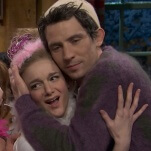The Fugitive broke new ground to become an unlikely hit
With so many new series popping up on streaming services and DVD every day, it gets harder and harder to keep up with new shows, much less the all-time classics. With TV Club 10, we point you toward the 10 episodes that best represent a TV series, classic or modern. If you watch these 10, you’ll have a better idea of what that series was about, without having to watch the whole thing. These are not meant to be the 10 best episodes, but rather the 10 most representative episodes.
The Fugitive, which first crept out of the shadows 50 years ago this month, may be the perfect television drama. That’s not to say that The Fugitive is superior to today’s best dramas, or even to its finest contemporaries, like The Defenders and Ben Casey. But The Fugitive achieved a perfection of form that was unique: It was part crime procedural, part action-adventure, and part character-driven melodrama. It was fusion TV. The push and pull between the contrasting generic elements meant that episodes were highly varied, but with so many different traditions to draw from, nearly always satisfying. The Fugitive achieved a phenomenally consistent level of quality—which makes this a particularly tough list to compile.
The Fugitive concerns a miscarriage of justice. Its backstory, chronicled in sound-bite form at the beginning of each episode, is as follows: Dr. Richard Kimble, an upstanding pediatrician in the small town of Stafford, Indiana, comes home one night to find his wife’s bludgeoned body. As their marriage had been on the rocks and there are no other obvious suspects, Kimble is convicted and sentenced to die. Freed by a train derailment on his way to death row, Kimble wanders the country under a series of aliases, working menial jobs and trying to blend in. Kimble’s only hope of turning his temporary reprieve into a permanent one is to find the man whom he suspects of having killed his wife: a one-armed drifter he saw running from his home on the night of the murder.
If that sounds a bit familiar, it’s because The Fugitive was a modern-dress update of Les Misérables (although creator Roy Huggins claimed he was more directly inspired by Westerns like his earlier hit, Maverick). It’s no accident that Kimble’s primary pursuer, Lt. Gerard—the Stafford police detective who first arrested him—has a name that sounds like his counterpart, Javert, in the Victor Hugo novel. Huggins thought the idea of the falsely accused man was so commonplace that it deserved to be called “the American theme,” and that the show would be an easy sell. He was wrong. Huggins spent two years peddling the idea before ABC president Leonard Goldenson bought it and assigned it to Quinn Martin, the up-and-coming independent producer who had turned The Untouchables into a hit. (Huggins had no further involvement with The Fugitive, although he ended up launching a rival show with a similar concept called Run For Your Life.)
The networks’ failure to grasp how compelling The Fugitive would become underscores the extent to which it broke new ground. It was the first television show about paranoia—the first whose protagonist was always looking over his shoulder—and perhaps the first that rested on an understanding that our social institutions can make mistakes that ruin lives. In an oblique way, The Fugitive channeled the social unrest of its time. It “spoke for a whole generation of people—kids like me, who grew up feeling slightly alienated from our parents,” wrote Fugitive fan Stephen King.
Even though cunning criminals had been getting away with murder for nearly a decade on Alfred Hitchcock Presents, the notion of a protagonist in a weekly series remaining permanently at odds with the law was revolutionary. One ABC executive called the premise “a slap in the face of American justice, week after week.” In that sense, The Fugitive is an important antecedent to the anti-hero cable dramas of the present day—even though Kimble himself, one of television’s great white knights, was anything but anti-heroic. The series went to considerable lengths to emphasize Kimble’s unwavering virtue. At the end of the pilot, as he slinks off into the night, Kimble even picks up a mewling stray kitten and gives it shelter in his coat. On paper, gestures like that one might seem to pander to the audience. In practice, they enriched the central irony that drove the series: Each week Kimble managed to solve some stranger’s problems, but never his own.
A guy who invariably stops to help an old lady cross the street in the middle of running from the electric chair might seem to strain credibility, right? What saved The Fugitive from absurdity was casting. David Janssen, a Clark Gable lookalike and former Universal contract player, had become a minor TV star in 1957 in Richard Diamond, Private Detective, part of a short-lived television fad for “jazz private eyes.” Too awkward to really succeed as a straight-arrow leading man, Janssen was waiting his turn for character parts. When he took on the role of Richard Kimble, he was only 32 but looked at least a decade older; although his purported alcoholism was not yet crippling, it would be by the end of The Fugitive’s grueling four-year run. As Kimble, he spoke in a staccato grumble, keeping his body taut and ready to bolt, his gaze on the ground or aimed at the nearest exit. If the scripts foregrounded Kimble’s nobility, Janssen’s expressive face filled in all the rest: the fear, the weariness, the exasperation of a life on the lam. Janssen kept The Fugitive anchored in an essential naturalism. Once a member of the intellectual class, Richard Kimble now worked as a bartender one week, a field laborer the next. He was one of the few TV characters seen doing manual labor on a regular basis, and Janssen was one of the few TV stars unglamorous enough to pull that off.
The aspect of The Fugitive that was the most ahead of its time was its villain. At best, the police in The Fugitive resemble the police in the films of Alfred Hitchcock (who had been famously traumatized by a childhood stint in a jail cell): unsmiling, implacable automatons. But The Fugitive went beyond that, often revealing the cops in pursuit of Kimble to be corrupt or sadistic. And Lt. Gerard—played with terrific control by Barry Morse—is a flat-out psycho. Hiding behind the excuse that he’s only doing his job, Gerard is clearly in the grip of an obsessive personal vendetta. Capturing Kimble is all about proving himself right and getting revenge on the con whose escape made him look stupid. Not incidentally, Gerard is a complete prick: He neglects his wife and child, and he’s always snide and condescending toward the local cops who tip him off on sightings of Dr. Kimble. “Lt. Gerard really scared me as a kid,” wrote Stephen King. “Kimble had made him crazy, and as The Fugitive went on you could see him heading further and further into freako land.” If Kimble is a far cry from Walter White, Lt. Gerard is only a few steps away from Vic Mackey.
Although it generally operated on the semi-anthology format devised by early dramas like Route 66—shows that devoted most of their screen time to the weekly guest stars, with the regular characters taking on almost secondary roles—The Fugitive gradually sketched in details about Kimble’s and Gerard’s families and various other figures connected to the Kimble murder trial. It was one of the first dramas to construct a mythology, although by today’s standards The Fugitive’s was rudimentary. Recurring characters were sometimes renamed, recast, or forgotten altogether. Perhaps because the television writers of the era weren’t accustomed to this kind of storytelling, some of the series’ milestone episodes are among the weaker entries—like “The Girl From Little Egypt,” the disappointing origin story that chronicles the Helen Kimble murder in flashback, or “Landscape With Running Figures,” the two-parter that pairs Kimble with a temporarily blind Mrs. Gerard. As a result, these recommendations favor the stand-alone episodes that were the show’s strong suit.












![HBO teases new Euphoria, Larry David, and much more in 2026 sizzle reel [Updated]](https://img.pastemagazine.com/wp-content/avuploads/2025/12/12100344/MixCollage-12-Dec-2025-09-56-AM-9137.jpg)



























